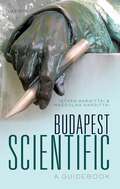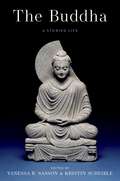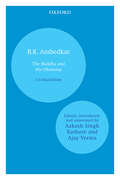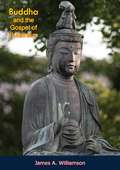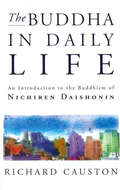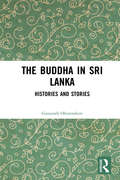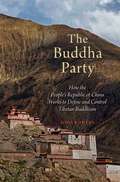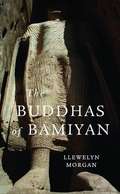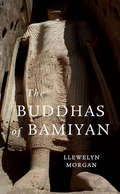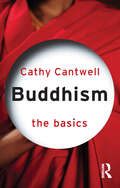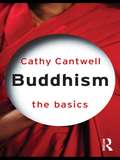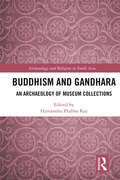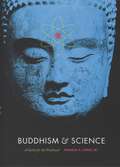- Table View
- List View
Budapest Scientific: A Guidebook
by István Hargittai Magdolna HargittaiThis guidebook introduces the reader to the visible memorabilia of science and scientists in Budapest - statues, busts, plaques, buildings, and other artefacts. According to the Hungarian-American Nobel laureate Albert Szent-Györgyi, this metropolis at the crossroads of Europe has a special atmosphere of respect for science. It has been the venue of numerous scientific achievements and the cradle, literally, of many individuals who in Hungary, and even more beyond its borders, became world-renowned contributors to science and culture. Six of the eight chapters of the book cover the Hungarian Nobel laureates, the Hungarian Academy of Sciences, the university, the medical school, agricultural sciences, and technology and engineering. One chapter is about selected secondary schools from which seven Nobel laureates (Szent-Györgyi, de Hevesy, Wigner, Gabor, Harsanyi, Olah, and Kertész) and the five "Martians of Science" (von Kármán, Szilard, Wigner, von Neumann, and Teller) had graduated. The concluding chapter is devoted to scientist martyrs of the Holocaust. A special feature in surveying Hungarian science is the contributions of scientists that left their homeland before their careers blossomed and made their seminal discoveries elsewhere, especially in Great Britain and the United States. The book covers the memorabilia referring to both émigré scientists and those that remained in Hungary. The discussion is informative and entertaining. The coverage is based on the visible memorabilia, which are not necessarily proportional with achievements. Therefore, there is a caveat that one could not compile a history of science relying solely on the presence of the memorabilia.
The Buddha: A Storied Life
by Vanessa R. Sasson and Kristin ScheibleRetellings of the Buddha's life story have animated and sustained Buddhist thought and practice through some 2,500 years of history. To this day, Buddhist holidays and rituals are pinned to the arc of his biography, celebrating his birth, awakening, teaching, and final nirvana. His story is the model that exemplary Buddhists follow. Often, there is a moment of insight akin to the Buddha's experience with the Four Sights, followed by a great departure from home, and a period of searching that it is hoped will lead to final awakening. The Buddha's story is not just the Buddha's story; it is the story of Buddhism. In this book, twelve leading scholars of South Asian texts and traditions articulate the Buddha-life blueprint--the underlying and foundational pattern that holds the life story of a buddha together. They retell the episodes of Buddha Gautama's extended life story, while keeping in mind the cosmic, paradigmatic arc of his narrative. The contributors have dedicated their careers to exploring hagiographical materials, each applying their own methodological and theoretical interests to shed new light on the enduring story of Buddhism. Using multiple perspectives, voices, and sources, this volume underscores the multivalent centrality of this story. The book will be an invaluable resource to practicing Buddhists and students of Buddhist Studies to help them engage in the most foundational story of the tradition.
The Buddha: A Storied Life
Retellings of the Buddha's life story have animated and sustained Buddhist thought and practice through some 2,500 years of history. To this day, Buddhist holidays and rituals are pinned to the arc of his biography, celebrating his birth, awakening, teaching, and final nirvana. His story is the model that exemplary Buddhists follow. Often, there is a moment of insight akin to the Buddha's experience with the Four Sights, followed by a great departure from home, and a period of searching that it is hoped will lead to final awakening. The Buddha's story is not just the Buddha's story; it is the story of Buddhism. In this book, twelve leading scholars of South Asian texts and traditions articulate the Buddha-life blueprint--the underlying and foundational pattern that holds the life story of a buddha together. They retell the episodes of Buddha Gautama's extended life story, while keeping in mind the cosmic, paradigmatic arc of his narrative. The contributors have dedicated their careers to exploring hagiographical materials, each applying their own methodological and theoretical interests to shed new light on the enduring story of Buddhism. Using multiple perspectives, voices, and sources, this volume underscores the multivalent centrality of this story. The book will be an invaluable resource to practicing Buddhists and students of Buddhist Studies to help them engage in the most foundational story of the tradition.
The Buddha and His Dhamma: A Critical Edition
by B.R. AmbedkarThe Buddha and His Dhamma was B.R. Ambedkar's last work. Published posthumously, it presented a radical reorientation of Buddhist thought and literature, aptly called navayana. It deals with Ambedkar's conceptualization of Buddhism and the possibilities it offered for liberation and upliftment of the Dalits. It presents his reflections on the life of the Buddha, his teachings, and the spread of Buddhism by interweaving anecdotes with detailed analyses of the religion's basic tenets. The author also includes important elements of the Buddhist canon and tradition to make the teachings more accessible. In the first critical and annotated edition of this work, the editors address the on-going debate on Ambedkar's interpretation of the Buddha's dhamma by focusing on the accuracy of his citations and providing missing sources. They also discuss Ambedkar's modification of source materials. The introduction contextualizes the scholarly work related to the text.
Buddha and the Gospel of Buddhism
by Ananda Coomaraswamy“THE aim of this book is to set forth as simply as possible the Gospel of Buddhism according to the Buddhist scriptures, and to consider the Buddhist systems in relation, on the one hand, to the Brahmanical systems in which they originate, and, on the other hand, to those systems of Christian mysticism which afford the nearest analogies. At the same time the endeavour has been made to illustrate the part which Buddhist thought has played in the whole development of Asiatic culture, and to suggest a part of the significance it may still possess for modern thinkers.“The way of the Buddha is not, indeed, concerned directly with the order of the world, for it calls on higher men to leave the marketplace. But the order of the world can only be established on a foundation of knowledge: every evil is ultimately traceable to ignorance. It is necessary, then, to recognize the world for what it truly is. Gautama teaches us that the marks of this life are imperfection, transcience, and the absence of any changeless individuality. He sets before us a summum bonum closely akin to the Christian mystic conception of ‘self-naughting.’ Here are definite statements which must be either true or false, and a clearly defined goal which we must either accept or refuse. If the statements be false, and if the goal be worthless, it is of the highest importance that the former should be refuted and the latter discredited. But if the diagnosis be correct and the aim worthy, it is at least of equal importance that this should be generally recognized: for we cannot wish to perpetuate as the basis of our sociology a view of life that is demonstrably false or a purpose demonstrably contrary to our conception of the good.“This book is designed, therefore, not as an addition to our already overburdened libraries of information, but as a definite contribution to the philosophy of life.”—Ananada K. Coomaraswamy
The Buddha and the Sahibs: The Men Who Discovered India's Lost Religion
by Charles AllenToday there are many Buddhists in the West, but for 2000 years the Buddha's teachings were unknown outside Asia. It was not until the late 18th century, when Sir William Oriental Jones, a British judge in India, broke through the Brahmin's prohibition on learning their sacred language. Sanskrit, that clues about the origins of a religion quite distinct from Hinduism began to be deciphered from inscriptions on pillars and rocks.This study tells the story of the search that followed, as evidence mounted that countries as diverse as Ceylon, Japan and Tibet shared a religion which had its origins in India yet was unknown there. British rule brought to India, Burma and Ceylon a whole band of enthusiastic Orientalist amateurs - soldiers, administrators and adventurers - intent on investigating the subcontinent's lost past. Unwittingly, these men helped lay the foundations for the revival of Buddhism in Asia during the 19th century and its spread to the West in the 20th. Charles Allen's book is a mixture of detective work and story-telling, as this acknowledged master of British Indian history pieces together early Buddhist history to bring a handful of extraoridinary characters to life.
The Buddha In Daily Life: An Introduction to the Buddhism of Nichiren Daishonin
by Richard Causton CaustonNichiren Daishonin Buddhism encourages the belief that, through its faith and practices, spiritual and material blessings and benefits can be available to everyone in this life. Needs can be met, and success achieved, not merely for oneself but for others (and the world) through dedication to the Lotus Sutra, a central teaching of Buddhism. It combines these personal objectives with the commitment to world peace, ecology and the easing of suffering, especially, AIDS. Attracting such well known followers as Jeff Banks, Sandie Shaw, Tina Turner and Roberto Baggio, Nichiren Daishonin Buddhism is rooted in a Buddhist tradition going back to the teachings of Nichiren in the 13th century, and is part of an international movement based in Japan.
The Buddha in Sri Lanka: Histories and Stories
by Gananath ObeyesekereThis book examines culture, religion and polity in the context of Buddhism. Gananath Obeyesekere, one of the foremost analytical voices from South Asia develops Freud’s notion of ‘dream work’, the ‘work of culture’ and ideas of no-self (anatta) to understand Buddhism in contemporary Sri Lanka. This work offers a restorative interpretation of Buddhist myths in contrast to the perspective involving deconstruction. The book deals with a range of themes connected with Buddhism, including oral traditions and stories, the religious pantheon, philosophy, emotions, reform movements, questions of identity and culture, and issues of modernity. This fascinating volume will greatly interest students, teachers and researchers of religion and philosophy, especially Buddhism, ethics, cultural studies, social and cultural anthropology, Sri Lanka and modern South Asian history.
The Buddha in Sri Lanka: Histories and Stories
by Gananath ObeyesekereThis book examines culture, religion and polity in the context of Buddhism. Gananath Obeyesekere, one of the foremost analytical voices from South Asia develops Freud’s notion of ‘dream work’, the ‘work of culture’ and ideas of no-self (anatta) to understand Buddhism in contemporary Sri Lanka. This work offers a restorative interpretation of Buddhist myths in contrast to the perspective involving deconstruction. The book deals with a range of themes connected with Buddhism, including oral traditions and stories, the religious pantheon, philosophy, emotions, reform movements, questions of identity and culture, and issues of modernity. This fascinating volume will greatly interest students, teachers and researchers of religion and philosophy, especially Buddhism, ethics, cultural studies, social and cultural anthropology, Sri Lanka and modern South Asian history.
The Buddha in the Attic (Bride Series)
by Julie OtsukaJulie Otsuka's The Buddha in the Attic, the follow-up to When the Emperor Was Divine was shortlisted for the 2011 National Book Award for Fiction and the 2011 Los Angeles Times Book Prize, and winner of the Pen Faulkner Award for Fiction 2012.Between the first and second world wars a group of young, non-English-speaking Japanese women travelled by boat to America. They were picture brides, clutching photos of husbands-to-be whom they had yet to meet. Julie Otsuka tells their extraordinary, heartbreaking story in this spellbinding and poetic account of strangers lost and alone in a new and deeply foreign land.'Sweeping, symphonic, empathic . . . subtle, infinitely skilful . . . an exhilarating, compulsive read. Otsuka's haunting, heartbreaking conclusion, in the aftermath of Pearl Harbor, is faultless' Daily Mail'A tender, nuanced, empathetic exploration of the sorrows and consolations of a whole generation of women . . . the distaff equivalent of a war memorial' Daily Telegraph'A haunting and heartbreaking look at the immigrant experience . . . Otsuka's keenly observed prose manages to capture whole histories in a sweep of gorgeous incantatory sentences' Marie Claire'An understated masterpiece... she conjures up the lost voices of a generation of Japanese American women without losing sight of the distinct experience of each' San Francisco ChronicleJulie Otsuka was born and raised in California. She is the author of the novel When the Emperor Was Divine, and a recipient of the Asian American Literary Award, the American Library Association Alex Award, and a Guggenheim fellowship. Her second novel, The Buddha in the Attic, was nominated for the 2011 National Book Award. She lives in New York City.
Buddha is Dead: Nietzsche and the Dawn of European ZEN
by Manu BazzanoDrawing on Zen as well as on Nietzsche's thought and its ramifications in and for western culture, this book is a fervent call for a re-visioning of philosophy as vocation. The author is critical of the status quo and committed to intellectual integrity; the result is a creative and adventurous enterprise which is no longer exclusively identified with academia or with the methodology of logic. Filtered through Nietzsche's hammer -- by which he sounded out gods old and new -- Buddhism in the West can avoid the pitfalls which emerged during its gestation period in the twentieth century: otherworldly spiritualism, conservatism, denial of the body. The philosophy of European Zen advocated by Manu Bazzano in 'Buddha is Dead: Nietzsche and the Dawn of European Zen' is an unconditional affirmation of living and dying to their fullest. It is an extraordinary fertile viewpoint that will be appreciated by all those who are interested in Eastern philosophy and religions, and who seek life-affirming wisdom.
The Buddha Party: How the People's Republic of China Works to Define and Control Tibetan Buddhism
by John PowersThe Buddha Party tells the story of how the People's Republic of China employs propaganda to define Tibetan Buddhist belief and sway opinion within the country and abroad. The narrative they create is at odds with historical facts and deliberately misleading but, John Powers argues, it is widely believed by Han Chinese. Most of China's leaders appear to deeply believe the official line regarding Tibet, which resonates with Han notions of themselves as China's most advanced nationality and as a benevolent race that liberates and culturally uplifts minority peoples. This in turn profoundly affects how the leadership interacts with their counterparts in other countries. Powers's study focuses in particular on the government's "patriotic education" campaign-an initiative that forces monks and nuns to participate in propaganda sessions and repeat official dogma. Powers contextualizes this within a larger campaign to transform China's religions into "patriotic" systems that endorse Communist Party policies. This book offers a powerful, comprehensive examination of this ongoing phenomenon, how it works and how Tibetans resist it.
The Buddha Party: How the People's Republic of China Works to Define and Control Tibetan Buddhism
by John PowersThe Buddha Party tells the story of how the People's Republic of China employs propaganda to define Tibetan Buddhist belief and sway opinion within the country and abroad. The narrative they create is at odds with historical facts and deliberately misleading but, John Powers argues, it is widely believed by Han Chinese. Most of China's leaders appear to deeply believe the official line regarding Tibet, which resonates with Han notions of themselves as China's most advanced nationality and as a benevolent race that liberates and culturally uplifts minority peoples. This in turn profoundly affects how the leadership interacts with their counterparts in other countries. Powers's study focuses in particular on the government's "patriotic education" campaign-an initiative that forces monks and nuns to participate in propaganda sessions and repeat official dogma. Powers contextualizes this within a larger campaign to transform China's religions into "patriotic" systems that endorse Communist Party policies. This book offers a powerful, comprehensive examination of this ongoing phenomenon, how it works and how Tibetans resist it.
Buddha to Krishna: Life and Times of George Keyt
by Yashodhara DalmiaThis book traces the emergence of modernism in art in South Asia by exploring the work of the iconic artist George Keyt. Closely interwoven with his life, Keyt’s art reflects the struggle and triumph of an artist with very little support or infrastructure. He painted as he lived: full of colour, turmoil and intensity. In this compelling account, the author examines the eventful course of Keyt’s journey, bringing to light unknown and startling facts: the personal ferment that Keyt went through because of his tumultuous relationships with women; his close involvement with social events in India and Sri Lanka on the threshold of Independence; and his somewhat angular engagement with artists of the ’43 Group. A collector’s delight, including colour plates and black and white photographs, reminiscences and intimate correspondences, this book reveals the portrait of an artist among the most charismatic figures of our time. This book will be of interest to scholars and researchers of art and art history, modern South Asian studies, sociology, cultural studies as well as art aficionados.
Buddha to Krishna: Life and Times of George Keyt
by Yashodhara DalmiaThis book traces the emergence of modernism in art in South Asia by exploring the work of the iconic artist George Keyt. Closely interwoven with his life, Keyt’s art reflects the struggle and triumph of an artist with very little support or infrastructure. He painted as he lived: full of colour, turmoil and intensity. In this compelling account, the author examines the eventful course of Keyt’s journey, bringing to light unknown and startling facts: the personal ferment that Keyt went through because of his tumultuous relationships with women; his close involvement with social events in India and Sri Lanka on the threshold of Independence; and his somewhat angular engagement with artists of the ’43 Group. A collector’s delight, including colour plates and black and white photographs, reminiscences and intimate correspondences, this book reveals the portrait of an artist among the most charismatic figures of our time. This book will be of interest to scholars and researchers of art and art history, modern South Asian studies, sociology, cultural studies as well as art aficionados.
The Buddhas of Bamiyan (Wonders of the world #16)
by Llewelyn MorganFor 1,400 years, two colossal Buddhas overlooked the Bamiyan Valley on the Silk Road in Afghanistan. The Buddhas embodied the intersection of East and West, and their destruction by the Taliban in 2001 provoked international outrage. Morgan excavates the layers of meaning these vanished wonders hold for a fractured Afghanistan.
The Buddhas of Bamiyan (Wonders of the world #16)
by Llewelyn MorganFor 1,400 years, two colossal Buddhas overlooked the Bamiyan Valley on the Silk Road in Afghanistan. The Buddhas embodied the intersection of East and West, and their destruction by the Taliban in 2001 provoked international outrage. Morgan excavates the layers of meaning these vanished wonders hold for a fractured Afghanistan.
The Buddha's Tooth: Western Tales of a Sri Lankan Relic (Buddhism and Modernity)
by John S. StrongJohn S. Strong unravels the storm of influences shaping the received narratives of two iconic sacred objects. Bodily relics such as hairs, teeth, fingernails, pieces of bone—supposedly from the Buddha himself—have long served as objects of veneration for many Buddhists. Unsurprisingly, when Western colonial powers subjugated populations in South Asia, they used, manipulated, redefined, and even destroyed these objects to exert control. In The Buddha’s Tooth, John S. Strong examines Western stories, from the sixteenth to the twentieth century, surrounding two significant Sri Lankan sacred objects to illuminate and concretize colonial attitudes toward Asian religions. First, he analyzes a tale about the Portuguese capture and public destruction, in the mid-sixteenth century, of a tooth later identified as a relic of the Buddha. Second, he switches gears to look at the nineteenth-century saga of British dealings with another tooth relic of the Buddha—the famous Daḷadā enshrined in a temple in Kandy—from 1815, when it was taken over by English forces, to 1954, when it was visited by Queen Elizabeth II. As Strong reveals, the stories of both the Portuguese tooth and the Kandyan tooth reflect nascent and developing Western understandings of Buddhism, realizations of the cosmopolitan nature of the tooth, and tensions between secular and religious interests.
BUDDHIS EXTREMISTS & MUSLIM MINORITIES C: Religious Conflict in Contemporary Sri Lanka
by John Clifford HoltWhen the civil war in Sri Lanka between Sinhala Buddhists and Tamils ended in 2009, many Sri Lankans and foreign observers alike hoped to see the re-establishment of relatively harmonious religious and ethnic relations among the various communities in the country. Instead, a different type of violence erupted, this time aimed at the Muslim community. The essays in Buddhist Extremists and Muslim Minorities investigate the history and current state of Buddhist-Muslim relations in Sri Lanka, in an attempt to identify the causes of this newly emergent conflict. Euro-American readers unfamiliar with this story will be surprised to learn that it inverts common stereotypes of the two religious groups. In this context, certain groups of Buddhists, generally considered peace-oriented in the West, are engaged in victimizing Muslims, who are increasingly seen as militant. The authors examine the historical contexts and substantive reasons that gave rise to Buddhist nationalism and aggressive attacks on Muslim communities. The rise of Buddhist nationalism in general is analyzed and explained, while the specific role, methods, and character of the militant Bodu Bala Sena ("Army of Buddhist Power") movement receive particular scrutiny. The motivations for attacks on Muslims may include deep-seated perceptions of economic disparity, but elements of religious culture (ritual and symbol) are also seen as catalysts for explosive acts of violence. This much-needed, timely commentary promises to shift the standard narrative on Muslims and religious violence.
Buddhism: The Basics (The Basics)
by Cathy CantwellBuddhism: The Basics provides a thorough and accessible introduction to a fascinating religion. Examining the historical development of Buddhism and its presence today, this guide covers: principal traditions practices and beliefs ethical guidelines and philosophy religious texts community With helpful features including a detailed map of the Buddhist world, glossary of terms and tips for further study, this is an ideal text for students and interested readers wanting to familiarise themselves with the Buddhist faith. Cathy Cantwell is an academic researcher at the Oriental Institute, University of Oxford. She specialises in Tibetan Buddhism, and has worked on eleventh century manuscripts, an eighteenth century scriptural collection, and contemporary Buddhist ritual manuals and practice. She has taught widely in UK Higher Education and is joint author of Early Tibetan Documents on Phur pa from Dunhuang.
Buddhism: The Basics (The Basics)
by Cathy CantwellBuddhism: The Basics provides a thorough and accessible introduction to a fascinating religion. Examining the historical development of Buddhism and its presence today, this guide covers: principal traditions practices and beliefs ethical guidelines and philosophy religious texts community With helpful features including a detailed map of the Buddhist world, glossary of terms and tips for further study, this is an ideal text for students and interested readers wanting to familiarise themselves with the Buddhist faith. Cathy Cantwell is an academic researcher at the Oriental Institute, University of Oxford. She specialises in Tibetan Buddhism, and has worked on eleventh century manuscripts, an eighteenth century scriptural collection, and contemporary Buddhist ritual manuals and practice. She has taught widely in UK Higher Education and is joint author of Early Tibetan Documents on Phur pa from Dunhuang.
Buddhism and Gandhara: An Archaeology of Museum Collections (Archaeology and Religion in South Asia)
by Himanshu Prabha RayGandhara is a name central to Buddhist heritage and iconography. It is the ancient name of a region in present-day Pakistan, bounded on the west by the Hindu Kush mountain range and to the north by the foothills of the Himalayas. ‘Gandhara’ is also the term given to this region’s sculptural and architectural features between the first and sixth centuries CE. This book re-examines the archaeological material excavated in the region in the nineteenth and early twentieth centuries and traces the link between archaeological work, histories of museum collections and related interpretations by art historians. The essays in the volume underscore the diverse cultural traditions of Gandhara – from a variety of sources and perspectives on language, ethnicity and material culture (including classical accounts, Chinese writings, coins and Sanskrit epics) – as well as interrogate the grand narrative of Hellenism of which Gandhara has been a part. The book explores the making of collections of what came to be described as Gandhara art and reviews the Buddhist artistic tradition through notions of mobility and dynamic networks of transmission. Wide ranging and rigorous, this volume will appeal to scholars and researchers of early South Asian history, archaeology, religion (especially Buddhist studies), art history and museums.
Buddhism and Gandhara: An Archaeology of Museum Collections (Archaeology and Religion in South Asia)
by Himanshu Prabha RayGandhara is a name central to Buddhist heritage and iconography. It is the ancient name of a region in present-day Pakistan, bounded on the west by the Hindu Kush mountain range and to the north by the foothills of the Himalayas. ‘Gandhara’ is also the term given to this region’s sculptural and architectural features between the first and sixth centuries CE. This book re-examines the archaeological material excavated in the region in the nineteenth and early twentieth centuries and traces the link between archaeological work, histories of museum collections and related interpretations by art historians. The essays in the volume underscore the diverse cultural traditions of Gandhara – from a variety of sources and perspectives on language, ethnicity and material culture (including classical accounts, Chinese writings, coins and Sanskrit epics) – as well as interrogate the grand narrative of Hellenism of which Gandhara has been a part. The book explores the making of collections of what came to be described as Gandhara art and reviews the Buddhist artistic tradition through notions of mobility and dynamic networks of transmission. Wide ranging and rigorous, this volume will appeal to scholars and researchers of early South Asian history, archaeology, religion (especially Buddhist studies), art history and museums.
Buddhism and Science: A Guide for the Perplexed (Buddhism and Modernity)
by Donald S. Lopez Jr.Beginning in the nineteenth century and continuing to the present day, both Buddhists and admirers of Buddhism have proclaimed the compatibility of Buddhism and science. Their assertions have ranged from modest claims about the efficacy of meditation for mental health to grander declarations that the Buddha himself anticipated the theories of relativity, quantum physics and the big bang more than two millennia ago. In Buddhism and Science, Donald S. Lopez Jr. is less interested in evaluating the accuracy of such claims than in exploring how and why these two seemingly disparate modes of understanding the inner and outer universe have been so persistently linked. Lopez opens with an account of the rise and fall of Mount Meru, the great peak that stands at the center of the flat earth of Buddhist cosmography—and which was interpreted anew once it proved incompatible with modern geography. From there, he analyzes the way in which Buddhist concepts of spiritual nobility were enlisted to support the notorious science of race in the nineteenth century. Bringing the story to the present, Lopez explores the Dalai Lama’s interest in scientific discoveries, as well as the implications of research on meditation for neuroscience. Lopez argues that by presenting an ancient Asian tradition as compatible with—and even anticipating—scientific discoveries, European enthusiasts and Asian elites have sidestepped the debates on the relevance of religion in the modern world that began in the nineteenth century and still flare today. As new discoveries continue to reshape our understanding of mind and matter, Buddhism and Science will be indispensable reading for those fascinated by religion, science, and their often vexed relation.
Buddhism and Science: A Guide for the Perplexed (Buddhism and Modernity)
by Donald S. Lopez Jr.Beginning in the nineteenth century and continuing to the present day, both Buddhists and admirers of Buddhism have proclaimed the compatibility of Buddhism and science. Their assertions have ranged from modest claims about the efficacy of meditation for mental health to grander declarations that the Buddha himself anticipated the theories of relativity, quantum physics and the big bang more than two millennia ago. In Buddhism and Science, Donald S. Lopez Jr. is less interested in evaluating the accuracy of such claims than in exploring how and why these two seemingly disparate modes of understanding the inner and outer universe have been so persistently linked. Lopez opens with an account of the rise and fall of Mount Meru, the great peak that stands at the center of the flat earth of Buddhist cosmography—and which was interpreted anew once it proved incompatible with modern geography. From there, he analyzes the way in which Buddhist concepts of spiritual nobility were enlisted to support the notorious science of race in the nineteenth century. Bringing the story to the present, Lopez explores the Dalai Lama’s interest in scientific discoveries, as well as the implications of research on meditation for neuroscience. Lopez argues that by presenting an ancient Asian tradition as compatible with—and even anticipating—scientific discoveries, European enthusiasts and Asian elites have sidestepped the debates on the relevance of religion in the modern world that began in the nineteenth century and still flare today. As new discoveries continue to reshape our understanding of mind and matter, Buddhism and Science will be indispensable reading for those fascinated by religion, science, and their often vexed relation.
